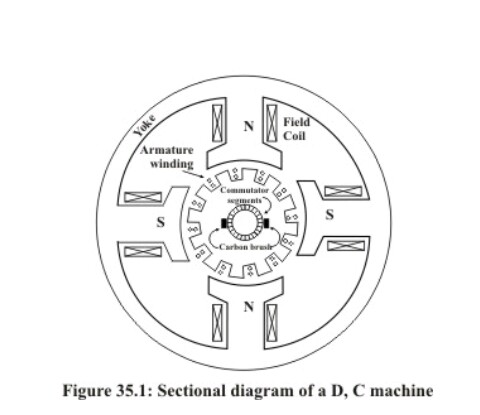Generally
DC generators are classified according to the ways of excitation of their fields. There are three methods of excitation.
- Field coils excited by permanent magnets – Permanent magnet DC generators.
- Field coils excited by some external source – Separately excited DC generators.
- Field coils excited by the generator itself – Self excited DC generators.
A brief description of these
type of generators are given below.
Permanent Magnet DC Generator

When the
flux in the
magnetic circuit is established by the help of permanent magnets then it is known as Permanent magnet DC generator.
It consists of an armature and one or several permanent magnets situated around the armature. This type of DC generators generates very low power. So, they are rarely found in industrial applications. They are normally used in small applications like dynamos in motor cycles.
Separately Excited DC Generator
These are the generators whose field magnets are energized by some external dc source such as
battery .
A circuit diagram of separately excited DC generator is shown in figure. I
a = Armature current I
L = Load current V = Terminal voltage E
g = Generated emf

Voltage drop in the armature = I
a × R
a(R/sub>a is the armature
resistance) Let, I
a = I
L = I (say) Then,
voltage across the load, V = IR
a Power generated, P
g = E
g×I Power delivered to the external load, P
L = V×I.
Self-excited DC Generators
These are the generators whose field magnets are energized by the
current supplied by themselves. In these type of machines field coils are internally connected with the armature. Due to residual magnetism some flux is always present in the poles. When the armature is rotated some emf is induced. Hence some induced current is produced. This small current flows through the field coil as well as the load and thereby strengthening the pole flux. As the pole flux strengthened, it will produce more armature emf, which cause further increase of current through the field. This increased field current further raises armature emf and this cumulative phenomenon continues until the excitation reaches to the rated value. According to the position of the field coils the
self-excited DC generators may be classified as…
- Series wound generators
- Shunt wound generators
- Compound wound generators
Series Wound Generator
In these type of generators, the field windings are connected in series with armature conductors as shown in figure below. So, whole current flows through the field coils as well as the load. As series field winding carries full load current it is designed with relatively few turns of thick wire. The
electrical resistance of series field winding is therefore very low (nearly 0.5Ω ). Let, R
sc = Series winding resistance I
sc = Current flowing through the series field R
a = Armature
resistance I
a = Armature current I
L = Load current V = Terminal voltage E
g= Generated emf

Then, I
a = I
sc = I
L=I (say) Voltage across the load, V = E
g -I(I
a×R
a) Power generated, P
g = E
g×I Power delivered to the load, P
L = V×I
Shunt Wound DC Generators
In these type of DC generators the field windings are connected in parallel with armature conductors as shown in figure below. In shunt wound generators the voltage in the field winding is same as the voltage across the terminal. Let, R
sh = Shunt winding
resistance I
sh = Current flowing through the shunt field R
a = Armature
resistance I
a = Armature current I
L = Load current V = Terminal voltage E
g = Generated emf

Here armature current I
a is dividing in two parts, one is shunt field current I
sh and another is load current I
L. So, I
a=I
sh + I
L The effective power across the load will be maximum when I
L will be maximum. So, it is required to keep shunt field current as small as possible. For this purpose the
resistance of the shunt field winding generally kept high (100 Ω) and large no of turns are used for the desired emf. Shunt field current, I
sh = V/R
shVoltage across the load, V = E
g-I
a R
aPower generated, P
g= E
g×I
a Power delivered to the load, P
L = V×I
L
Compound Wound DC Generator
In series wound generators, the output voltage is directly proportional with load current. In shunt wound generators, output voltage is inversely proportional with load current. A combination of these two types of generators can overcome the disadvantages of both. This combination of windings is called compound wound DC generator. Compound wound generators have both series field winding and shunt field winding. One winding is placed in series with the armature and the other is placed in parallel with the armature. This type of DC generators may be of two types- short shunt compound wound generator and long shunt compound wound generator.
Short Shunt Compound Wound DC Generator
The generators in which only shunt field winding is in parallel with the
armature winding as shown in figure.

Series field current, I
sc = I
L Shunt field current, I
sh = (V+I
sc R
sc)/R
shArmature current, I
a = I
sh + I
L Voltage across the load, V = E
g - I
a R
a - I
sc R
scPower generated, P
g = E
g×I
a Power delivered to the load, P
L=V×I
L
Long Shunt Compound Wound DC Generator
The generators in which shunt field winding is in parallel with both series field and
armature winding as shown in figure.

Shunt field current, I
sh=V/R
shArmature current, I
a= series field current, I
sc= I
L+I
sh Voltage across the load, V=E
g-I
a R
a-I
sc R
sc=E
g-I
a (R
a+R
sc) [∴I
a=I
cs] Power generated, P
g= E
g×I
aPower delivered to the load, P
L=V×I
LIn a compound wound generator, the shunt field is stronger than the series field. When the series field assists the shunt field, generator is said to be commutatively compound wound. On the other hand if series field opposes the shunt field, the generator is said to be differentially compound wound.

 When the flux in the magnetic circuit is established by the help of permanent magnets then it is known as Permanent magnet DC generator.
When the flux in the magnetic circuit is established by the help of permanent magnets then it is known as Permanent magnet DC generator. Voltage drop in the armature = Ia × Ra(R/sub>a is the armature resistance) Let, Ia = IL = I (say) Then, voltage across the load, V = IRa Power generated, Pg = Eg×I Power delivered to the external load, PL = V×I.
Voltage drop in the armature = Ia × Ra(R/sub>a is the armature resistance) Let, Ia = IL = I (say) Then, voltage across the load, V = IRa Power generated, Pg = Eg×I Power delivered to the external load, PL = V×I. Then, Ia = Isc = IL=I (say) Voltage across the load, V = Eg -I(Ia×Ra) Power generated, Pg = Eg×I Power delivered to the load, PL = V×I
Then, Ia = Isc = IL=I (say) Voltage across the load, V = Eg -I(Ia×Ra) Power generated, Pg = Eg×I Power delivered to the load, PL = V×I Here armature current Ia is dividing in two parts, one is shunt field current Ish and another is load current IL. So, Ia=Ish + IL The effective power across the load will be maximum when IL will be maximum. So, it is required to keep shunt field current as small as possible. For this purpose the resistance of the shunt field winding generally kept high (100 Ω) and large no of turns are used for the desired emf. Shunt field current, Ish = V/RshVoltage across the load, V = Eg-Ia RaPower generated, Pg= Eg×Ia Power delivered to the load, PL = V×IL
Here armature current Ia is dividing in two parts, one is shunt field current Ish and another is load current IL. So, Ia=Ish + IL The effective power across the load will be maximum when IL will be maximum. So, it is required to keep shunt field current as small as possible. For this purpose the resistance of the shunt field winding generally kept high (100 Ω) and large no of turns are used for the desired emf. Shunt field current, Ish = V/RshVoltage across the load, V = Eg-Ia RaPower generated, Pg= Eg×Ia Power delivered to the load, PL = V×IL Series field current, Isc = IL Shunt field current, Ish = (V+Isc Rsc)/RshArmature current, Ia = Ish + IL Voltage across the load, V = Eg - Ia Ra - Isc RscPower generated, Pg = Eg×Ia Power delivered to the load, PL=V×IL
Series field current, Isc = IL Shunt field current, Ish = (V+Isc Rsc)/RshArmature current, Ia = Ish + IL Voltage across the load, V = Eg - Ia Ra - Isc RscPower generated, Pg = Eg×Ia Power delivered to the load, PL=V×IL Shunt field current, Ish=V/RshArmature current, Ia= series field current, Isc= IL+Ish Voltage across the load, V=Eg-Ia Ra-Isc Rsc=Eg-Ia (Ra+Rsc) [∴Ia=Ics] Power generated, Pg= Eg×IaPower delivered to the load, PL=V×ILIn a compound wound generator, the shunt field is stronger than the series field. When the series field assists the shunt field, generator is said to be commutatively compound wound. On the other hand if series field opposes the shunt field, the generator is said to be differentially compound wound.
Shunt field current, Ish=V/RshArmature current, Ia= series field current, Isc= IL+Ish Voltage across the load, V=Eg-Ia Ra-Isc Rsc=Eg-Ia (Ra+Rsc) [∴Ia=Ics] Power generated, Pg= Eg×IaPower delivered to the load, PL=V×ILIn a compound wound generator, the shunt field is stronger than the series field. When the series field assists the shunt field, generator is said to be commutatively compound wound. On the other hand if series field opposes the shunt field, the generator is said to be differentially compound wound.

 Three most important characteristic of shunt wound dc generators are discussed below:
Three most important characteristic of shunt wound dc generators are discussed below:
 The terminal voltage can always be maintained constant by adjusting the of the load terminal.
The terminal voltage can always be maintained constant by adjusting the of the load terminal.











